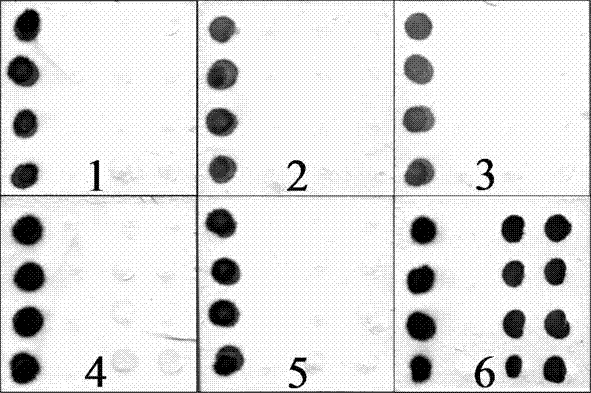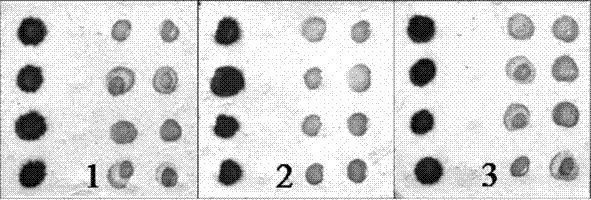Protein chip for rapid quantitative determination of bacterial fruit blotch of watermelon and preparation method thereof
A quantitative detection and protein chip technology, which is applied in measurement devices, instruments, scientific instruments, etc., to achieve the effects of simple operation, good promotion prospects, and good specificity
- Summary
- Abstract
- Description
- Claims
- Application Information
AI Technical Summary
Problems solved by technology
Method used
Image
Examples
Embodiment 1
[0028] Embodiment 1: as figure 1 As shown, a protein chip for rapid quantitative detection of watermelon fruit spot bacteria is a biochip in which at least one watermelon fruit spot bacteria capture antibody D is immobilized on a chip substrate. An enzyme-labeled IgG antibody is also immobilized on the substrate as a positive control P, and a spotting buffer as a negative control N; the substrate is a nitrocellulose membrane (NC). The enzyme-labeled IgG is alkaline phosphatase-labeled IgG, which is fixed on the chip base as a positive control for protein chip quality control. See figure 1 , on the substrate from left to right in the order of positive control P, negative control N, and capture antibody D, and spot 0.2 μL of each point sequentially, including 4 replicates of positive control and 4 replicates of negative control, and 8 replicates of capture antibody.
Embodiment 2
[0029] Embodiment 2: A kind of preparation method of the protein chip of rapid quantitative detection watermelon fruit spot bacterium, comprises the following steps:
[0030] a. Substrate pretreatment: the substrate needs to be treated with ddH before use 2 O soaking, and drying constant; The soaking time is at least 15min, preferably 30min; The drying temperature is 15-37°C, preferably 25°C;
[0031] b. Chip spotting preparation: Dilute the capture antibody with spotting buffer, and take enzyme-labeled IgG and spotting buffer as positive control and negative control respectively, spot and fix according to the design; the spotting buffer Liquid is 0.001-0.5mol / L, the carbonate buffer solution that pH value is 7.0-10.0, preferably 0.05mol / L, the carbonate buffer solution that pH is 9.6, and carbonate buffer solution is Na 2 CO 3 1.59 g, NaHCO 3 2.93 g, NaN 3 0.2 g, ddH 2 O 1000 mL; the concentration of the capture antibody is 20-80mg / L, preferably 80 mg / L; the described...
Embodiment 3
[0032] Embodiment 3: the preparation of watermelon fruit blotch protein chip
[0033] Nitrocellulose membrane substrate with ddH 2 Soak in O for 30 min and dry at 25°C for 30 min. Dilute the capture antibody to 80mg / L with 0.05mol / L carbonate buffer, and use alkaline phosphatase-labeled IgG as a positive control, and carbonate buffer as a negative control. See figure 1 , on the substrate from left to right in the order of positive control P, negative control N, and capture antibody D, and spot 0.2 μL of each point sequentially, including 4 replicates of positive control and 4 replicates of negative control, and 8 replicates of capture antibody. After sample application, the substrates were placed in a wet box, fixed at 37°C for 20 min, and stored at 4°C for later use. The capture antibody and detection antibody used were purchased from Agdia Company, Cat. No. SRA 14800.
PUM
 Login to View More
Login to View More Abstract
Description
Claims
Application Information
 Login to View More
Login to View More - R&D
- Intellectual Property
- Life Sciences
- Materials
- Tech Scout
- Unparalleled Data Quality
- Higher Quality Content
- 60% Fewer Hallucinations
Browse by: Latest US Patents, China's latest patents, Technical Efficacy Thesaurus, Application Domain, Technology Topic, Popular Technical Reports.
© 2025 PatSnap. All rights reserved.Legal|Privacy policy|Modern Slavery Act Transparency Statement|Sitemap|About US| Contact US: help@patsnap.com



